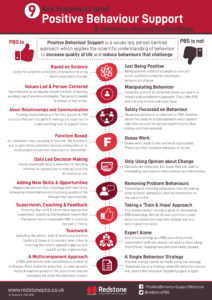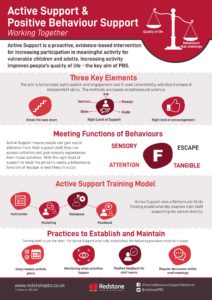Welcome to the our Positive Behaviour Support resources page! You will find links to our key Positive Behaviour Support resources including case studies, blogs and as well as our online learning site & video resources. Our online learning site includes a range of freely available Positive Behaviour Support resources such as videos and short presentations. Below we have also included some detailed information about Positive Behaviour Support and Active Support alongside information about terms used within PBS.
Definitions and Glossary
Positive Behaviour Support
The PBS approach has strong value base, keeping the person at the centre and promoting valued social roles for people in society. An essential part of PBS is the scientific understanding of how all behaviour works.
The main aim of Positive Behaviour Support is to increase an individual’s quality of life by increasing opportunities and skills. An increase in quality of life has the effect of reducing behaviours that challenge. Have a look at our infographic.
Active Support
Active Support is an intervention for training staff to increase activity, engagement and participation for people with intellectual disabilities. It is based on behavioural principles, is evidence-based and is an essential part of the PBS.
We know that increasing participation and engagement improves quality of life and for those people who need a greater degree of support, this approach is essential. Active Support is trained to staff in a specific way, this includes both information based training, role plays and in situ training. Have a look at our infographic.
This is the application of the understanding of the scientific principles of behaviour to socially significant behavioural issues. The aim is to bring about meaningful change in a person’s life. See UK SBA website link on resources page.
Autism can vary greatly in severity but is life-long, effects development and impacts an individual’s ability to communicate, socialise or understand social situations, it can often be accompanied by other learning or developmental disabilities. See website of the National Autistic Society on resources page
These are behaviours that a person presents which pose a challenge to society, family members or organisations supporting or educating the person. For example, shouting or screaming in a public place, physical aggression towards others or destruction of property, etc.Behaviours that challenge have been defined as ‘culturally abnormal behaviour of such intensity, frequency or duration that the physical safety of the person or others is likely to be placed in serious jeopardy, or behaviour which is likely to seriously limit use of, or result in the person being denied access to, ordinary community facilities’ (Emerson 1995, 2001)
This is a branch of psychology concerned with the assessment and treatment of mental ill health and behavioural issues.
This approach emphasises the aim of adding to behaviour repertoires that a person already has, with the aim of increasing skills and opportunities. This is in contrast to an approach where behaviour that is seem as problematic is reduced through behavioural interventions.
The use of approaches that have proven to be effective through scientific studies published in peer-reviewed journals and when implemented are monitored to ensure effectiveness.
Functional assessment is a range of methods for assessing why a particular behaviour or behaviours occur. This assessment identifies the function of the behaviour and therefore ensures that intervention plans are based on the function, leading to effective behaviour change. If we do not know the function of a behaviour we risk putting into place ineffective or inappropriate interventions or support plans which can make the situation or behaviour of concern worse
This is the application of behavioural principles within the structures of organisations. It includes, performance management, behaviour systems analysis and behaviour based safety.
This is a collection of senior professionals who work both in academic and clinical settings who have expertise in PBS. They have worked together to develop professional standards of the PBS approach and practice in the UK. there are number of free, useful resources on the PBS Academy website.
Person centred approaches put the focus person at the centre of care provisions and packages, rather than the service, school or college. Decisions made about the person are based on what they want and need, rather than what is best for others. Where possible the person is supported to make decisions about their own life.
PCP is a set of approaches designed to assist someone to plan their life and support. It is used most often as a life planning model to enable individuals with disabilities or otherwise requiring support to increase their personal self-determination and improve their own independence, skills and opportunities.
PSR is a quality assurance management system designed to define, monitor and improve employee and organisational performance. It uses defined quality standards, performance monitoring and performance feedback. It allows staff teams and managers to determine their services and organisation’s areas of strength and weakness and, therefore, where additional training, resources or focus are needed to improve the quality of services.
‘Social, emotional and behavioural difficulties’ is an umbrella term used to describe a range of complex and chronic difficulties experienced by children and young people. It can include being socially withdrawn or isolated, displaying disruptive or disturbing behaviour, presenting as hyperactive and lacking in ability to concentrate, having difficulties with social skills or presenting with behaviours that challenge arising from other complex special needs. It may also be used in relation to children and young people who experience anxiety or depression or self-harm.
SRV is defined as the use of culturally valued means to enable, establish, enhance, maintain, and/or defend valued social roles for people at risk of not being seen as valued members of society (Wolfensberger, 1985, 1998, 2000).
Systemic approaches view issues within the context of the system in which they are expressed. Rather than identifying a specific person as having a ‘problem’ the issue is identified as being part of the system and as such changes are viewed in terms of the systems of interaction between each person in the system. A systemic approach uses discussion and exchanges of viewpoint to facilitate communication and change within that system.




